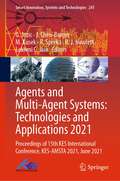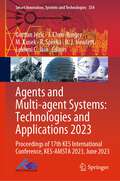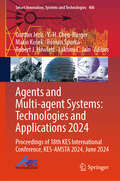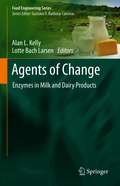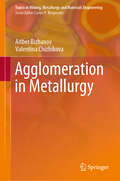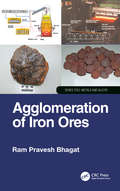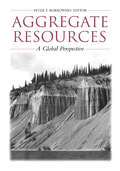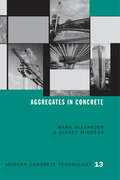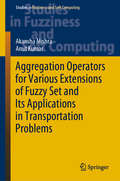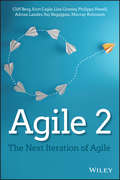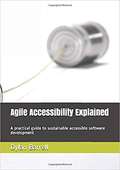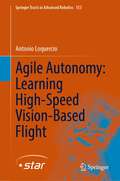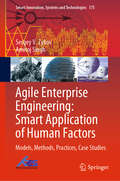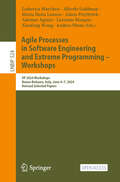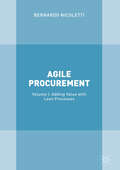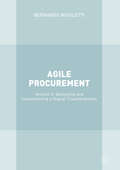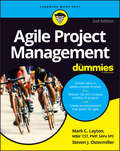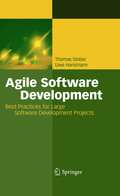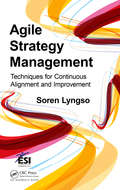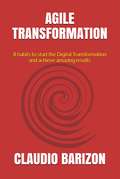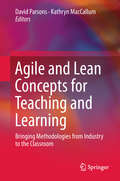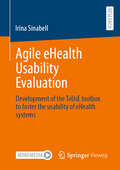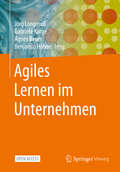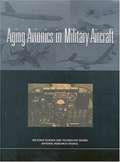- Table View
- List View
Agents and Multi-Agent Systems: Proceedings of 15th KES International Conference, KES-AMSTA 2021, June 2021 (Smart Innovation, Systems and Technologies #241)
by Lakhmi C. Jain G. Jezic J. Chen-Burger M. Kusek R. Sperka R. J. HowlettThis book highlights new trends and challenges in research on agents and the new digital and knowledge economy. It includes papers on business process management, agent-based modeling and simulation, and anthropic-oriented computing that were originally presented at the 15th International KES Conference on Agents and Multi-Agent Systems: Technologies and Applications (KES-AMSTA 2021), being held as a Virtual Conference in June 14–16, 2021. The respective papers cover topics such as software agents, multi-agent systems, agent modeling, mobile and cloud computing, big data analysis, business intelligence, artificial intelligence, social systems, computer embedded systems, and nature-inspired manufacturing, all of which contribute to the modern digital economy.
Agents and Multi-Agent Systems: Proceedings of 16th KES International Conference, KES-AMSTA 2022, June 2022 (Smart Innovation, Systems and Technologies #306)
by Lakhmi C. Jain Robert J. Howlett Gordan Jezic Yun-Heh Jessica Chen-Burger Mario Kusek Roman ŠperkaThe book highlights new trends and challenges in research on agents and the new digital and knowledge economy. It includes papers on business process management, agent-based modeling and simulation and anthropic-oriented computing that were originally presented at the 16th International KES Conference on Agents and Multi-Agent Systems: Technologies and Applications (KES-AMSTA 2022), held at Rhodes, Greece in June 20–22, 2022. The respective papers cover topics such as software agents, multi-agent systems, agent modeling, mobile and cloud computing, big data analysis, business intelligence, artificial intelligence, social systems, computer embedded systems and nature inspired manufacturing, all of which contribute to the modern digital economy.
Agents and Multi-agent Systems: Proceedings of 17th KES International Conference, KES-AMSTA 2023, June 2023 (Smart Innovation, Systems and Technologies #354)
by Lakhmi C. Jain Gordan Jezic J. Chen-Burger M. Kusek R. Sperka R. J. HowlettThis book highlights new trends and challenges in research on agents and the new digital and knowledge economy. It includes papers on business process management, agent-based modeling and simulation and anthropic-oriented computing that were originally presented at the 17th International KES Conference on Agents and Multi-Agent Systems: Technologies and Applications (KES-AMSTA 2023), held in Rome, Italy, in June 14–16, 2023. The respective papers cover topics such as software agents, multi-agent systems, agent modeling, mobile and cloud computing, big data analysis, business intelligence, artificial intelligence, social systems, computer embedded systems and nature-inspired manufacturing, all of which contribute to the modern digital economy.
Agents and Multi-agent Systems: Proceedings of 18th KES International Conference, KES-AMSTA 2024, June 2024 (Smart Innovation, Systems and Technologies #406)
by Lakhmi C. Jain Robert J. Howlett Gordan Jezic Roman Šperka Y.-H. Chen-Burger Mario KušekThis book highlights new trends and challenges in research on agents and the new digital and knowledge economy. It includes papers on business process management, agent-based modeling and simulation and anthropic-oriented computing that were originally presented at the 18th International KES Conference on Agents and Multi-Agent Systems: Technologies and Applications (KES-AMSTA 2024), held in Madeira, Portugal, on June 19–21, 2024. The respective papers cover topics such as software agents, multi-agent systems, agent modeling, mobile and cloud computing, big data analysis, business intelligence, artificial intelligence, social systems, computer-embedded systems and nature-inspired manufacturing, all of which contribute to the modern digital economy.
Agents of Change: Enzymes in Milk and Dairy Products (Food Engineering Series)
by Alan L. Kelly Lotte Bach LarsenThe enzymology of milk and other products is of enormous significance for the production and quality of almost every dairy product. Milk itself is a complex biological fluid that contains a wide range of enzymes with diverse activities, some of which have identifiable functions while others are present as an accidental consequence of the mechanism of milk secretion. Over time milk enzymology has become an incredibly essential component of milk and other dairy product production, and with advancing technology and processing techniques, its importance is at its peak. Dairy Enzymology presents an expansive overview of the enzymology of milk and other dairy products, focusing on the use of indigenous and endogenous enzymes in milk and exogenous enzymes in cheese processing. A full section is dedicated to the enzymology of bovine milk, focusing on the main families of indigenous enzymes as well as their potential significance in the mammary gland plus the technological significance for the properties of dairy products. Implications for the manufacture and ripening of cheese plus the use of enzymes such as alkaline phosphatase for measuring heat treatment in milk are explored in full, and the role of milk protease plasmin and other indigenous enzymes in the age-gelation is focused on. Further sections focus on enzymes found in raw milk and enzymes deliberately added for manufacture or modification of properties and the manufacture of food ingredients from dairy-derived ingredients. The key bacterial families are discussed in depth as well as their known contributions to the quality of dairy products. With its comprehensive scope and fully up-to-date coverage of dairy product enzymology, this text is a singular source for researchers looking to understand this essential dairy processing aspect.
Agglomeration in Metallurgy (Topics in Mining, Metallurgy and Materials Engineering)
by Aitber Bizhanov Valentina ChizhikovaThis book gives details on the processes of agglomeration and its role in modern metal production processes. It starts with a chapter on sinter production, also discussing the quality of sinter and environmental aspects involved on the process. The following chapters focus on pellet production and briquetting of natural and anthropogenic raw materials. It also highlights the best available technologies for briquetting by stiff extrusion.
Agglomeration of Iron Ores (Metals And Alloys Ser.)
by Ram Pravesh BhagatThis book focuses on agglomeration, or the size enlargement process, of iron ores. This process sits at the interface of mineral processing and extractive metallurgy. The book begins with a discussion of raw materials preparation and the beneficiation process. It then describes fundamental principles of the sintering and pelletization processes, including formation of green mix through granulation and green balls as well as chemical reactions during sintering. Finally, it offers a brief description of iron making processes and correlations related to the agglomerates: quality parameters and BF productivity and coke rate.
Aggregate Resources: A Global Perspective
by Peter T. BobrowskyAggregate Resources provides a comprehensive collection of 27 diverse scientific papers on aggregate topics, such as geology of deposits, geophysical exploration techniques, deposit prediction and modeling, land-use case studies, production values and trends, geotechnical properties, legislation politics and others. This diversity in subject matter is further enhanced by relying on contributions from a number of countries including Australia, Belgium, Canada, Lebanon, the Netherlands, Norway, South Africa, the United Kingdom and the United States. The range of topical papers and representative countries, coupled with the global significance of the resources prompted the title Aggregate Resources: A global perspective. The book will appeal to all those involved with aggregate resources: geologists, producers, technicians , construction engineers, developers, land-use planners, legislators, academics and the public consumer, especially since all of us are in some manner, directly dependent or indirectly affected by this resource. *Each chapter is a study on a particular area of importance for aggregate producers. Pit & Quarry, April 1998.
Aggregates in Concrete (Modern Concrete Technology)
by Mark Alexander Sidney MindessThis book provides a detailed guide to the selection and use of aggregates in concrete. It presents an overview of aggregate sources and production techniques, followed by a detailed study of their physical, mechanical and chemical properties. Then it looks at the use of aggregates in both plastic and hardened concretes, and in the overall mix design. Special aggregates and their applications are discussed, as are the current main specifications, standards and tests.
Aggregation Operators for Various Extensions of Fuzzy Set and Its Applications in Transportation Problems (Studies in Fuzziness and Soft Computing #399)
by Amit Kumar Akansha MishraThis book introduces readers to the fundamentals of transportation problems under the fuzzy environment and its extensions. It also discusses the limitations and drawbacks of (1) recently proposed aggregation operators under the fuzzy environment and its various extensions; (2) recently proposed methods for solving transportation problems under the fuzzy environment; and (3) recently proposed methods for solving transportation problems under the intuitionistic fuzzy environment. In turn, the book proposes simplified methods to overcome these limitations.
Agile 2: The Next Iteration of Agile
by Adrian Lander Kurt Cagle Cliff Berg Lisa Cooney Philippa Fewell Raj Nagappan Murray RobinsonAgile is broken. Most Agile transformations struggle. According to an Allied Market Research study, "3% of respondents stated the failure of agile implementation in their organizations." The problems with Agile start at the top of most organizations with executive leadership not getting what agile is or even knowing the difference between success and failure in agile. Agile transformation is a journey, and most of that journey consists of people learning and trying new approaches in their own work. An agile organization can make use of coaches and training to improve their chances of success. But even then, failure remains because many Agile ideas are oversimplifications or interpreted in an extreme way, and many elements essential for success are missing. Coupled with other ideas that have been dogmatically forced on teams, such as "agile team rooms", and "an overall inertia and resistance to change in the Agile community," the Agile movement is ripe for change since its birth twenty years ago. "Agile 2" represents the work of fifteen experienced Agile experts, distilled into Agile 2: The Next Iteration of Agile by seven members of the team. Agile 2 values these pairs of attributes when properly balanced: thoughtfulness and prescription; outcomes and outputs, individuals and teams; business and technical understanding; individual empowerment and good leadership; adaptability and planning. With a new set of Agile principles to take Agile forward over the next 20 years, Agile 2 is applicable beyond software and hardware to all parts of an agile organization including "Agile HR", "Agile Finance", and so on. Like the original "Agile", "Agile 2", is just a set of ideas - powerful ideas. To undertake any endeavor, a single set of ideas is not enough. But a single set of ideas can be a powerful guide.
Agile Accessibility Explained: A Practical Guide to Sustainable Accessible Software Development
by Dylan A. BarrellYears of experience down in the trenches of accessibility remediation projects, driven by lawsuits related to the Americans with Disabilities Act (ADA) or laws like the Accessibility for Ontarians with Disabilities Act (AODA) in Canada have given Mr. Barrell experience as to the practices that work when implementing sustainable accessible software development. He has collected these together in a very practical guide on how to do agile accessible development that goes from the design and usability phase all the way through to deployment. On the way it deals with continuous integration and delivery, issue tracking, testing and coding as well as the organizational practices required to support the individual agile teams. A must read for anyone who takes accessibility seriously.
Agile Autonomy: Learning High-Speed Vision-Based Flight (Springer Tracts in Advanced Robotics #153)
by Antonio LoquercioThis book presents the astonishing potential of deep sensorimotor policies for agile vision-based quadrotor flight. Quadrotors are among the most agile and dynamic machines ever created. However, developing fully autonomous quadrotors that can approach or even outperform the agility of birds or human drone pilots with only onboard sensing and computing is challenging and still unsolved.Deep sensorimotor policies, generally trained in simulation, enable autonomous quadrotors to fly faster and more agile than what was possible before. While humans and birds still have the advantage over drones, the author shows the current research gaps and discusses possible future solutions.
Agile Enterprise Engineering: Models, Methods, Practices, Case Studies (Smart Innovation, Systems and Technologies #175)
by Sergey V. Zykov Amitoj SinghThis concise book provides a survival toolkit for efficient, large-scale software development. Discussing a multi-contextual research framework that aims to harness human-related factors in order to improve flexibility, it includes a carefully selected blend of models, methods, practices, and case studies. To investigate mission-critical communication aspects in system engineering, it also examines diverse, i.e. cross-cultural and multinational, environments. This book helps students better organize their knowledge bases, and presents conceptual frameworks, handy practices and case-based examples of agile development in diverse environments. Together with the authors’ previous books, "Crisis Management for Software Development and Knowledge Transfer" (2016) and "Managing Software Crisis: A Smart Way to Enterprise Agility" (2018), it constitutes a comprehensive reference resource adds value to this book.
Agile Processes in Software Engineering and Extreme Programming – Workshops: XP 2024 Workshops, Bozen-Bolzano, Italy, June 4–7, 2024, Revised Selected Papers (Lecture Notes in Business Information Processing #524)
by Xiaofeng Wang Ademar Aguiar Alfredo Goldman Adam Przybyłek Lorraine Morgan Lodovica Marchesi Maria Ilaria Lunesu Andrea PinnaThis open access book constitutes revised selected papers from the workshops held at the 25th International Conference on Agile Software Development, XP 2024, which took place in Bozen-Bolzano, Italy, during June 04-07, 2024. XP is the premier agile software development conference combining research and practice. It is a unique forum where agile researchers, practitioners, thought leaders, coaches, and trainers get together to present and discuss their most recent innovations, research results, experiences, concerns, challenges, and trends. XP conferences provide an informal environment to learn and trigger discussions and welcome both people new to agile and seasoned agile practitioners. This year’s conference was held with the theme “Reflect, Adapt, Envision”. The 29 papers included in this volume were carefully reviewed and selected from 58 submissions to the following tracks: International Workshop on Advances in Software Intensive Startups Workshop on AI for Agile Software Engineering (AI4ASE) 2nd International Workshop on Global and Hybrid Work in Software Engineering (GoHyb) 11th International Workshop on Large-Scale Agile Development Workshop on the AI Scrum Master: Incorporating AI Into Your Agile Practices and Processes Agile Training and Education Track PhD Symposium Track Posters Track
Agile Procurement: Volume I: Adding Value with Lean Processes
by Bernardo NicolettiThis book is the first of two volumes presenting a business model to add value through Procurement. Including several case studies of successful implementation, it demonstrates how the increasing complexity of the business environment requires a significant intervention on the management of processes and information within individual organizations and through inter-company relations. Agile Procurement presents the application of the Agile method which optimises and digitizes processes in order to reduce wastage and defects. As a method, tool and a culture aimed at effectiveness, efficiency and economy of organisations, agile procurement requires a change of paradigm. This volume examines these areas of improvement and presents best practice in improving processes. Each chapter of the book presents and substantiates the costs and benefits of process improvement through agile procurement. This is is seen as the integration of Lean Six Sigma and digitization.
Agile Procurement: Volume II: Designing and Implementing a Digital Transformation
by Bernardo NicolettiThis book is the first of two volumes presenting a business model to add value through Procurement. Including several case studies of successful implementation, it demonstrates how the increasing complexity of the business environment requires a significant intervention on the management of processes and information within individual organizations and through inter-company relations. Agile Procurement presents the application of the Agile method which optimises and digitizes processes in order to reduce wastage and defects. As a method, tool and a culture aimed at effectiveness, efficiency and economy of organisations, agile procurement requires a change of paradigm. This volume examines these areas of improvement and presents best practice in improving processes. Each chapter of the book presents and substantiates the costs and benefits of process improvement through agile procurement. This is is seen as the integration of Lean Six Sigma and digitization.
Agile Project Management For Dummies
by Mark C. Layton Steven J. OstermillerFlex your project management muscle Agile project management is a fast and flexible approach to managing all projects, not just software development. By learning the principles and techniques in this book, you'll be able to create a product roadmap, schedule projects, and prepare for product launches with the ease of Agile software developers. You'll discover how to manage scope, time, and cost, as well as team dynamics, quality, and risk of every project. As mobile and web technologies continue to evolve rapidly, there is added pressure to develop and implement software projects in weeks instead of months—and Agile Project Management For Dummies can help you do just that. Providing a simple, step-by-step guide to Agile project management approaches, tools, and techniques, it shows product and project managers how to complete and implement projects more quickly than ever. Complete projects in weeks instead of months Reduce risk and leverage core benefits for projects Turn Agile theory into practice for all industries Effectively create an Agile environment Get ready to grasp and apply Agile principles for faster, more accurate development.
Agile Software Development: Best Practices for Large Software Development Projects
by Thomas Stober Uwe HansmannSoftware Development is moving towards a more agile and more flexible approach. It turns out that the traditional "waterfall" model is not supportive in an environment where technical, financial and strategic constraints are changing almost every day. But what is agility? What are today's major approaches? And especially: What is the impact of agile development principles on the development teams, on project management and on software architects? How can large enterprises become more agile and improve their business processes, which have been existing since many, many years? What are the limitations of Agility? And what is the right balance between reliable structures and flexibility? This book will give answers to these questions. A strong emphasis will be on real life project examples, which describe how development teams have moved from a waterfall model towards an Agile Software Development approach.
Agile Strategy Management: Techniques for Continuous Alignment and Improvement (ESI International Project Management Series #18)
by Soren LyngsoYour strategic initiatives are constantly under fire due to the evolving nature of markets, technology, laws, and government. To ensure your strategy succeeds, it must remain flexible while confronting these shifting challenges. Agile Strategy Management: Techniques for Continuous Alignment and Improvement explains how to achieve this flexibility by building agility into the initiation, development, implementation, and governance of your strategic initiatives.The book details what it takes to initiate, develop, implement, and govern a healthy strategy that delivers the benefits expected by all stakeholders. It presents insights gained by the author’s organization over the last 25 years helping their clients achieve success with their strategic initiatives. Filled with real-world examples and case studies, it illustrates wide-ranging situations where the author’s company helped clients reach important business objectives.Readers can use the book to look up examples that describe the various ways to use agile methods and techniques for critical business functions, including: Scope definition of strategic initiatives Stakeholder identification Team building Project and program quality management Change management Procurement of resources Solution development, implementation, and quality management Strategy governance In this book, you will find guidelines that explain how to establish internal organizations for change and how to ensure these intermediate organizations stay motivated until final solution delivery. Presenting success stories as well as major blunders, the book can help you avoid many of the pitfalls that other organizations have experienced while governing their strategic initiatives.
Agile Transformation: 8 habits to start Digital Transformation and achieve incredible results
by Claudio BarizonAgile Transformation is the answer for organisations that need to modernise to meet the challenges imposed by Digital Transformation and the new behaviours of the increasingly dissatisfied and volatile consumer, whose desires can be met quickly and are within reach of their palm. In this new complex world of accelerated change, there is no room for organisations that still have their processes, policies and management models based on bureaucracy, rigid and highly hierarchical organisational structures, with practices that worked in the past. These organisations have difficulties in anticipating market changes and disruption, which are hitting industry by industry and putting at risk their own survival or, at least, their ability to prosper. With this book, you will have a new perspective on teamwork and get to know genuine collaboration. We will present very simple and practical working methods that guarantee the delivery of value from your team, through a new management model: agile and collaborative. These concepts were put into practice, with different emphases, formats and methods, in various organisations with great success. And this was the motivation for writing the book: to disseminate the transforming experience, which was one of the foundations for the creation of the startup Zehnk, where the author is co-founder. The objective is to share this experience and show organisations that it is possible to build motivated, proactive and innovative teams, able to work in an integrated manner, with total transparency in communication and with common objectives, even if their members do not belong to the same area, department or company. Or are not physically together. True collaborative work happens when the team has autonomy, self-management and responsibility, generating deep engagement and incredible results. It is where everyone seeks what is best for the organisation and its product or service: results and value for the business are pu
Agile and Lean Concepts for Teaching and Learning: Bringing Methodologies from Industry to the Classroom
by David Parsons Kathryn MacCallumThis book explores the application of agile and lean techniques, originally from the field of software development and manufacturing, to various aspects of education. It covers a broad range of topics, including applying agile teaching and learning techniques in the classroom, incorporating lean thinking in educational workflows, and using team-based approaches to student-centred activities based on agile principles and processes.Demonstrating how agile and lean ideas can concretely be applied to education, the book offers practical guidance on how to apply these ideas in the classroom or lecture hall, as well as new concepts that could spark further research and development.
Agile eHealth Usability Evaluation: Development of the ToUsE toolbox to foster the usability of eHealth systems
by Irina SinabellThe integration of usability evaluations into iterative software development processes is becoming increasingly relevant, as gathering feedback from prospective users is crucial to improving the usability of eHealth systems. Traditional approaches to eHealth usability evaluation, however, are difficult to reconcile with the iterative software development process, which is why there is an increasing need for agile usability evaluation. Despite the existence of approaches to agile usability evaluation, it is unclear whether they are suitable to rapidly evaluate patient-centered eHealth systems being iteratively developed in health care applicable, for prospective users such as elderly persons suffering from age-related declines. This research includes an innovative and comprehensive toolbox called ToUsE, toolbox for eHealth usability evaluation, which consists of more than 40 rapidly deployable and potentially useful eHealth usability evaluation methods developed by the author. The ToUsEtoolbox is intended for use by software developers, medical informaticians, usability experts, or medical professionals who aim at performing an eHealth usability evaluation. The book provides detailed descriptions of all the eHealth usability evaluation methods included in ToUsE.
Agiles Lernen im Unternehmen
by Benjamin Höhne Jörg Longmuß Gabriele Korge Agnes BauerDieses Open Access-Buch zeigt, dass Kompetenzentwicklung im Unternehmen so flexibel und innovativ sein kann, wie es die Arbeit oft schon ist. Der Ansatz „Agiles Lernen im Unternehmen“ wendet agile Methoden auf die betriebliche Weiterbildung an. Beschäftigte entwickeln neue Kompetenzen direkt im Arbeitsumfeld, die Herangehensweise ist dynamisch und kann im Verlauf des Lernens sich wandelnden Anforderungen und Rahmenbedingungen angepasst werden. Fachliche und methodische Begleiter unterstützen das Lernen und richten es am Bedarf des Unternehmens aus. Das Buch stellt Agiles Lernen im Unternehmen umfassend dar: Der erste Teil beschreibt den Hintergrund und das Vorgehen im Einzelnen. Im zweiten Teil werden sieben ausgewählte agile Lernprojekte aus sehr unterschiedlichen Unternehmen vorgestellt. Der dritte Teil behandelt übergreifende Themen zu Gestaltung, Organisation und Perspektive des agilen Lernens. Es lädt dazu ein, den Ansatz selbst auszuprobieren.
Aging Avionics in Military Aircraft
by National Research Council Air Force Science Technology BoardA summary of Aging Avionics in Military Aircraft
